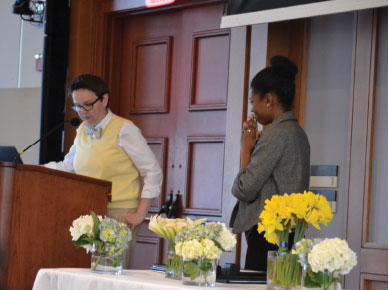How Simmons College measures up
By Taylor Rapalyea
Staff Writer
U.S. News and World Report calls Simmons College one of the best regional colleges in its 2014 rankings, and says 77.3 percent of students at the college receive need-based financial aid. But are financial services at Simmons as strong as this would have us believe?
Antonia Baron, a senior Public Health major, doesn’t think so. Prior to her first year at Simmons, her financial aid advisor, Mehrdad Kermani, failed to tell her that she needed to take out a loan to pay for her tuition. And as a first generation college student, she had no idea how to go about getting one.
“Simmons sent me a bill for $11,000,” said Baron. “When I asked, ‘Oh, where’s this $11,000 bill coming from?’”
She paused. “Well, you didn’t get a loan to cover the cost.’ Well [my financial aid advisor] didn’t say I needed one.”
Baron and her father had to scrape together the money in order to pay it in full by its due date. “That was really difficult – that was a penny-pinching time. But I mean, it worked out.”
College Data found that 1,282 out of 1,900 Simmons’ undergraduate applicants were determined to have financial need. Of these, 99.2 percent received aid, but only 220 students who were not determined to have need were given merit-based aid.
Those statistics aren’t bad, unless you consider the many flaws that are present in determining who gets need-based aid. Need-based aid is determined at a college’s discretion, and the amount of need determined is rarely met. At Simmons, only 9.4 percent of students had their need fully met. The average percent of need met in colleges nationally is 66.3, according to the latest statistics.
According to higher education blogger Lynn O’Shaughnessy, not only are there issues in calculating how much a family can afford, but there is also a gap between that and what colleges expect them to pay.
“Meager financial aid packages force too many families to borrow more than they should and compel parents to raid their retirement accounts,” wrote O’Shaughnessy in the New York Times. “Colleges are spending less on students who need a financial hand and instead are funneling more of their dollars into merit scholarships for rich students.”
Andrea Teague, Baron’s financial aid officer, says that it is the Admissions Office that determines a student’s need-based aid.
With the U.S. economy on a hopeful, but timid upswing, and the costs of a college education skyrocketing, colleges everywhere are seeing a decline in their applicant pools. At Simmons, however, the number of applicants has gone up.
“At many schools, they’re saying, ‘Look, before we could stand to lose the people who can’t afford it,’” Sandy Baum, senior associate at the Institute for Higher Education Policy, told Inside Higher Ed. Now they can’t, she said.
Need versus merit-aid has become a battle for funding to the point where the few students who do receive merit-based aid are too embarrassed to admit it, regardless of financial standing. When they do confess to their circumstances, they’re met with anger from their less fortunate peers.
“People tend to think that academics are easier for me, or I’m under less stress, just because I don’t have as much of a financial burden,” said one such recipient at Simmons.
“I can understand it, but it doesn’t mean I don’t worry about things like maintaining the necessary GPA or finding a career I like or getting into grad school – those are still real challenges for me.”
While merit-based aid can seem hard to come by for most, a recent report out of the New America Foundation titled “Undermining Pell,” found that the amount of merit-based aid has risen nationally from 13 to 18 percent among high-income students since 2007, while the amount of need-based aid has experienced a downtick of 41 percent to 37 percent amid low-income students.
“[I]nstitutions tend to use their institutional financial aid as a competitive tool to reel in the top students, as well as the most affluent, to help them climb up the U.S. News & World Report rankings and maximize their revenue,” states the report.
Most colleges are having complications with financial aid, but when it comes to the logistics, Simmons seems to be lagging a little extra. Baron noted that since her first snafu with financial services, things went pretty smoothly for her. At least, things were going well until the institution switched her advisor from Kermani to Teague, who has a Master’s in Women and Cultural Studies from Simmons College.
“I’m no genius, but I’m really thinking they hired her because she’s a Simmons alum, and they’re trying to make offices mainly Simmons,” said Baron, speaking rapidly. “But I’m sorry; she’s not qualified to do the job that she’s doing. My loans were late because of her, my bill was wrong five times because of her.”
Baron wasn’t exaggerating when she said her bill was incorrect five times. In July, she requested a tuition bill, and was sent five separate documents with the wrong sum that Baron needed to get her loans. It wasn’t until she came to Simmons in person and met with her previous advisor, Kermani, that she got a correct bill.
Teague does have prior college administration experience – she was an academic advisor at a technical school. She noted that many students seem to be surprised at the cost of tuition, regardless of the college, but said that she hadn’t gotten many complaints about financial aid packages.
According to the U.S. Department of Education, Simmons is ranked as having one of the highest net prices for a private, not-for-profit, 4-year or above college. The net price after scholarships and grant aid for the 2010-11 year was $33,300, compared to a national average of $19,330.
Other schools that made this list include Berklee College, the New School, Northeastern University, and the New England Conservatory of Music.
Vice President of Finances at Simmons, Stefano Falconi, commented that the college tries to give everyone a little bit, so no one “pays the full sticker price.”
“I don’t think Simmons is a generous school,” said O’Shaughnessy. “I think they’re pretty stingy. Which is pretty typical for schools on the East.”
She went on to note that Simmons only meets 76 percent of need, which is “horrible,” but not uncommon for schools in a location like Boston or New York.
“Only schools that are most prestigious and have wealthy students at the schools can afford to meet 100 percent of need,” said O’Shaughnessy.
Public records show that Simmons raked in $149,040,949 in total revenue in 2011, the latest year open to public inspection. Program service expenses came to $115,806,556, and functional expenses totaled $2,860,000. Salaries, which are optional to record, were not disclosed. At the end of the year, with all expenses accounted for, barring salaries, Simmons had a net balance of $204,932,149.
In a presentation given to the Board of Trustees, President Helen Drinan outlined improving financial aid as a priority for the 2015 fiscal year. Simmons currently gives an average award of $24,139.
But while financial aid at Simmons may not be the best nationally, Simmons graduates are notorious for getting the best out of their buck. Kiplinger reported that the college ranked 80 on the list of Top Valued Private Colleges in New England.















Caroline58 • Dec 10, 2013 at 10:57 pm
This article lacks journalistic integrity and is full of biased opinions by this “staff writer.” I would like to instead consider the quality of journalism – or lack there of – the School of Communications is teaching their students. How could such a biased story be published. I see no evidence of fact checking, citing of real sources, or identifying the opposing sides of this story. Even if this were presented as an Op Ed story, the writer should have provided more balance and more factual information to give her readers a fairer portrayal of the real Simmons Financial aid situation today. Shame on you Simmons Voice for publishing this merit-less, sloppy, embarrassing article. What happened to the journalist credo of “giving voice to the voiceless?” I’m sure there are many students and alumni out there who would like the opportunity to contradict or correct the statements made about them and others in this story. Next time, let’s hope Ms. Rapalyea, gives them the courtesy to do so.
Kate Clavet • Dec 6, 2013 at 1:14 pm
When I was at Simmons College Mehrdad was my financial advisor and spent a lot of time and went to great lengths to explain my financial package and what I needed to do to pay my obligated amount. He also always got back to me and answered any questions I had in a very timely-manner. I find it hard to believe that his actions are accurately discussed in this article. I doubt he’s changed, especially since while I was there he helped me get my work study grant back after it was taken away, which I desperately needed.